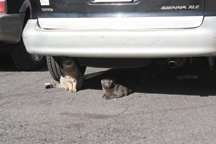Even when you don’t see them, they are there, colonies of feral cats living in people’s backyards, abandoned lots, and along the waterways on every side of the city.
They come out at night, when you can hear them, or when misguided people dump food – especially in problem areas.
“People think they are doing a good thing when they put out food,” said Kathleen Henderson, founder of the Bayonne Feral Cat Foundation, last week. “But they aren’t. Putting out food attracts rodents as well as cats, and that’s a problem.”
Bayonne’s City Council is poised to introduce an ordinance that would help control feral cats throughout the city, in conjunction with the Bayonne Feral Cat Foundation.
“This ordinance would help control the cat population and yet still allow the cats to get the care they need.” – Councilman Gary LaPelusa
________
Hoping for support
Henderson said she does not know how much support the ordinance will get from the City Council when it is introduced at the April 21 meeting, but she has met with Jason O’Donnell, the director of constituent services for the town, as well as Councilman Gary La Pelusa and attorney Michelle Lerner, to clear up legal issues that kept the ordinance from being introduced several times since last August,when La Pelusa first proposed it.
A feral cat is described as wild or untamed. These cats are extremely fearful and resist contact with humans. Most live in small groups known as colonies near homes or businesses where people feed them.
These cats were either born outside and never lived with a human family, or were house cats that were lost and forced to fend for themselves. Many die from exposure or accidents. If they have not been sterilized, they give birth to feral kittens, and the cycle continues.
A stray cat is not a feral cat. The difference is that a stray cat is one who has been abandoned by its owner or has strayed from its home and gotten lost. They are generally friendly and seek out human contact. A stray can usually be re-socialized and adopted.
“This is a win-win situation for everybody,” he said. “This ordinance would help control the cat population and yet still allow the cats to get the care they need.”
The law
If passed, the ordinance would allow the foundation to designate official caregivers who would be allowed to feed cats throughout the city. But designation comes with several caveats. These caregivers would be required to catch, neuter, and then maintain the felines when they are released.
Caregivers would be allowed to feed colonies of feral cats, but must also make sure food is not left out for rodents and others, and the caregiver would have to monitor the health of the cats, making certain they receive medical attention when necessary.
“It isn’t enough just to neuter and release them,” Henderson said, noting the foundation would report to the health department at intervals on the progress of these colonies as well as an estimate of how many cats there are.
The ordinance would require the foundation to obtain and maintain insurance for all of its operations, and the city would not be held liable for the activities of caregivers, trappers or sponsors.
The foundation would also be responsible for resolving complaints over the conduct of a colony or a caregiver, and to report the location of colonies of cats, and show records of vaccinations and neutering.
An annual report to the city would detail the number of colonies in the city, the number of cats in each colony, number of cats spayed and neutered, and the number of cats and kittens placed into permanent homes.
The foundation would be responsible for all of the costs associated with the program.
A companion ordinance would prohibit people from feeding feral cats unless the cats are spayed, neutered and vaccinated.
Henderson said feral cats caught generally can’t be adopted out. Adult feral cats usually can’t be socialized, and won’t adjust to living indoors or with a human family. Feral kittens up to 10 weeks of age can often be tamed and placed into homes. Older kittens will require much more time and effort.
“If they are taken to a shelter, they are euthanized, not adopted,” she said. “So it is better to put them back after they have been spayed and neutered. But it can’t stop there. We have to maintain them, which means to make certain they get their shots and medical attention if they need it.”
Colony behind supermarket
The ordinances are also designed to stop people from feeding cats indiscriminately, such as people who might come out of A&P and dump food on the ground, which would attract other animals, such as rats.
She said while there are known areas with cat colonies, such as behind the A&P off Avenue A, the feral cat population is very likely much larger than people think.
LaPelusa said the new ordinances were delayed partly because of a misreading of state law.
“The city thought the state prohibited the feeding of feral cats,” La Pelusa said. “This is apparently not the case, and there are about 160 communities around the state that have ordinances that allow for the feeding of feral cats.”
People who are interested in becoming caregivers can call the foundation at (201) 437-3232.
Al Sullivan may be reached at asullivan@hudsonreporter.com.
